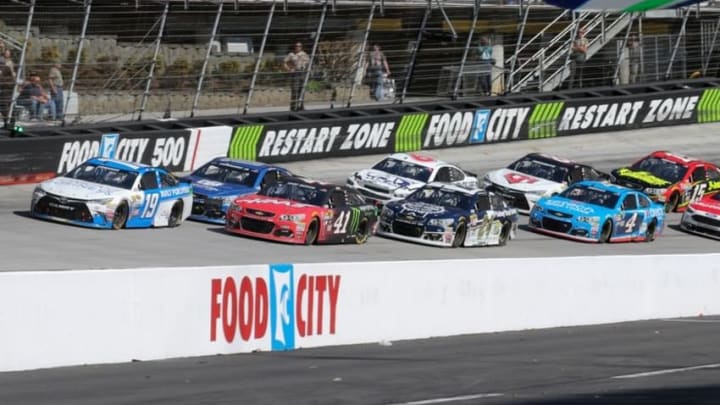Bristol and Martinsville proved NASCAR needs to make a change when it comes to restarts.
Is it time for NASCAR to change the lineup procedure for caution flag restarts? During the Sprint Cup race at Martinsville two weeks ago, we saw all the cars restarting on the inside have a huge advantage over the cars on the outside lane. At Bristol, on every restart when cars had equal tires, at least the fourth-place car (which restarts on the outside of row 2) and sometimes up to four cars passed the – thanks to their faster pit crew – second-place car, who always started on the inside of row 1.
For example, prior to a caution on lap 410, Carl Edwards, Kevin Harvick, and Kurt Busch were running 1-2-3. Their pit crews all did their respective jobs and the cars restarted 1-2-3, with Edwards on the outside of row 1, Harvick on the inside of row 1, and Busch on the inside of row 2.
After the restart on lap 417, which car was in second-place? That would be the 78 of Martin Truex Jr., who restarted fourth. It was not that Harvick and Busch got poor restarts, they were just in the wrong lane at the wrong time.
On lap 437 there was a caution and several cars stayed out instead of pitting. Chase Elliott had passed his way up to third-place under green, only to fall behind Kurt Busch, who had been fourth, on the restart on lap 449. Then on the following caution on lap 460, Busch was third and Elliott was fourth, so naturally shortly after they threw the green flag on lap 467 Elliott passed Busch back AND passed Kevin Harvick on the inside for second. From fourth.
Naturally when the caution flew on lap 485, Elliott still found himself in second. After the restart on lap 491, Elliott was third, having been passed by the fourth-place restarter, Busch. And then, to add insult to injury, the caution flew again on lap 492, putting third-place Elliott in the worst possible spot for the restart. Dale Earnhardt Jr. restarted fourth on lap 496 and of course passed Busch and Elliott for second.
Not only that, but the final restart of the Xfinity race saw Kyle Larson and Erik Jones – the first two cars on the outside – blow past Kyle Busch, who was leading the inside, on the way to Jones passing Larson for the win.
Why is NASCAR happy with a system where at some tracks a pit crew and driver who perform two, four, or even six spots better than a competitor only to end up at a disadvantage due to which lane the cars the cars occupy on the restart? It seems counter-intuitive that a faster team is punished for being faster on tracks where lane choice is so important.
Why doesn’t NASCAR change the restart lineup procedure so that the best cars end up in the most preferred spots? All you would have to do is line the cars up single file coming out of turn two, and then let them line up as they choose, inside or outside, in the order as they are running. Give the teams a five second-limit to decide their lane, line them up, and throw the green.
Consider: perhaps during the early race cautions, instead of lining up in the “bad” lane, the second-place driver could line up behind the leader, knowing that they are more likely to be second-place a couple of laps after the restart rather than third or fourth. And which driver would be the first one to try the bad lane…would it be the third or fourth-place car? What if there were teammates involved…would that affect the lane choices?
Late in the race, lane choice could be as critical a decision as whether to take two or four tires, or to pit or not. Maybe coming to a green/white/checkered the second-place team would make a more aggressive choice to start next to the leader? I mean, NASCAR Sprint Cup crew chiefs get paid to make critical decisions, so why not give them one more to make?
More racing: NASCAR: Winner And Losers From Bristol
When I think about things I would change about NASCAR, I try to imagine the sport being created today and if doing things “because we’ve always done them that way” was not an issue. I really don’t think that if it became apparent that fourth-place was the second-best place to be on the racetrack that NASCAR would like to keep things that way. The teams and drivers should be rewarded for being aggressive and being ahead of their competitors under all circumstances. It would be easy to fix this restart situation, where some teams are at a disadvantage for “doing better”.
